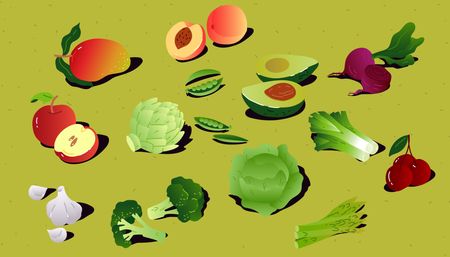Your gut microbiome is a symbiotic ecosystem that adapts to you - that's why physical activity is good for your gut microbes.
There’s a whole world living inside your colon (i.e., the large intestine), and it does a bunch of important stuff. This ecosystem is mainly made up of bacteria that perform a range of essential functions for digestive and overall health.
It's called the gut microbiome. It eats what you eat, it gets stressed when you do, and now science shows that the composition and functions of your gut bacteria are enhanced by exercise and physical activity.
Table of contents
- Your microbiome is a self-portrait
- Microbial diversity is essential for health
- What can exercise do for my microbiome?
- Gut microbial diversity and physical activity
- What sports can improve your microbiome?
- Do I need a microbiome test?
In this article, we’ll review some microbiome basics before diving into the exciting findings about physical exercise, like how it increases microbial diversity and how to apply these findings to your daily life.
☝️DISCLAIMER☝️ This article is for informational purposes. Always consult your GP if you plan on implementing changes to your exercise routine, especially if you have been leading a sedentary lifestyle with little or no physical activity.
Your microbiome is a self-portrait
Imitation is the sincerest form of flattery, we’re told. And in this case, you should be very flattered, because your microbiome looks just like you (well nearly).
Thanks to genetic sequencing technology, humanity recently discovered how essential our gut microbes are for good health, and how much they reflect our daily lives and naughty indulgences. But first, we should probably explain what the fuss is about bacteria.
In a nutshell, your gut bacteria produce fatty acids, vitamins, and amino acids that have a range of beneficial effects for the body, from promoting healthy immune system function to maintaining the integrity of the gut lining.
You can learn more about the composition of your gut microbiome and how it affects your health with the Atlas Biomed Microbiome Test.
Microbial diversity is essential for health
We have a win-win arrangement with our microbes when we live a healthy life: we give these single-celled organisms a home, and they work hard alongside us.
Diversity is a key parameter for measuring microbiome health, and this ecosystem is made up of hundreds of species. A diverse microbiota profile is associated with enhanced vitamin and short-chain fatty acid (SCFA) production, dietary fibre metabolism, and even increased disease protection.
On the other hand, there’s a word for a poor or imbalanced ecosystem that can’t adequately do its job for the host, a human. It’s called dysbiosis. When dysbiosis affects the gut, the communities of beneficial and benign bacteria that usually make up the microbiota are altered, leading to digestive symptoms and conditions.
What can exercise do for my microbiome?
Studies have shown, for example, that even little changes can yield results. For example, increasing the frequency of moderate exercise from never to daily leads to a greater diversity in Firmicutes.
This phylum (a taxonomic rank) of bacteria includes Faecalibacterium prausnitzii, species of Oscillospira, as well as members of the Lachnospira and Coprococcus genera that contribute to a healthier gut environment.
Another study we will explore later looked at how physical exercise in women affects the microbiome. It found that doing exercise was correlated with higher representation of bacteria with health-promoting functions in females.
These included F. prausnitzii and Roseburia hominis, known for their butyrate-producing abilities, and Akkermansia muciniphila that is abundant in athletes, and low levels are associated with metabolic conditions, like obesity and diabetes.
Research comparing elite athletes to sedentary controls (average human participants that don’t do much physical exercise) also highlights that the microbiome is much more than just a gut thing.
One major study investigated the microbiomes of 40 professional international rugby union players compared to control groups of people of similar age with either high or low BMI. It highlighted “significantly greater intestinal microbial diversity among the athletes”.
SCFAs are organic compounds produced by gut bacteria from tough-to-digest plant fibres in your diet. In particular, butyrate has been shown to have a number of health-promoting functions.
Among other things, butyrate is the main source of fuel for the cells of the gut lining, helping to maintain its integrity, reduce inflammation, and prevent organic compounds from foods, toxins, and metabolites from crossing into the bloodstream.
The study also identified increases in the metabolic pathways of the microbiome (a series of chemical reactions within a cell):
- production of amino acids, essential building blocks of cells
- antibiotic biosynthesis that supports immune system function
- carbohydrate metabolism that provides fuel
In short, physical exercise has been shown to provide tangible improvement for several markers associated with physical performance and health, particularly in terms of beneficial types of bacteria and their functions.
REMEMBER ☝️Protection from obesity and diabetes, as well as potential for butyrate production and the composition of your microbiome, are traits you can check with the Atlas Biomed Tests.
Gut microbial diversity and physical activity
You may rightly wonder whether physical exercise transforms the microbiota, or if having a healthy microbiota makes you more inclined to be active. It’s a chicken-or-egg scenario that scientists are looking at from both angles.
A 2017 study, this time in women, demonstrated that physical exercise “can modify the composition of gut microbiota” in a positive way. Differences in gut microbiota profile between women with active lifestyle and sedentary women by Carlo Bressa and colleagues studied two groups of women between the ages of 18 and 40.
Active participants were selected for the group that performed at least 10 hours of physical exercise over a 7-day period during the trial. The sedentary group participated in quiet activities and were selected from women who weren’t particularly active in their daily lives, performing less than 30 minutes of moderate exercise three times per week.
Eleven genera (a taxonomic rank of bacteria) were “significantly different between active and sedentary women”. Importantly, the active group of women had a “higher abundance of health-promoting bacterial species, including Faecalibacterium prausnitzii, Roseburia hominis, and Akkermansia muciniphila”.
They also found that “body fat percentage, muscular mass, and physical activity significantly correlated with several bacterial populations.” Basically, leading an active lifestyle was more pleasing to some bacteria than others, and that’s a very good thing.
What sports can improve your microbiome?
Physical activity is divided into two categories, strength and endurance, that are determined by how your body produces energy to fuel your performance.
VO2 max accounts for 20% of the variation in taxonomic richness
Strength sports require high-intensity effort, like weight lifting, sprinting, and boxing. These sports build muscle mass by exercising your cells' anaerobic pathways. That means that your muscles use their limited glycogen stores to create ATP (the fuel for your muscles) without using oxygen.
This differs from endurance sports that allow the body to perform exercise at a lower intensity, but for much longer periods, like long-distance running, cycling, and skiing. Such activities are considered aerobic because the muscles use oxygen to transform fats and sugars into ATP for fuel.
Several studies indicate a relationship between microbiota composition and cardiorespiratory fitness that can account for more than 20% of the variation in "taxonomic richness" (diversity of bacteria identified in the microbiome). These changes were noted to be independent of other factors, including age, fat intake, and carbohydrate intake.
Cardio is the way to go
As we've seen, studies indicate that aerobic exercise, commonly known as cardio, has benefits for your microbiota, both in terms of increased abundance of beneficial bacteria and overall diversity.
Walking, running, dancing, cycling, the elliptical machine, and the rower at the gym are all examples of cardio workouts. However, the intensity and duration of your workout will vary depending on your general fitness level.
If you are just dipping your toes into the exercise pond, you might not be able to sustain your effort for long. And that is totally okay because cardio is all about the long run. Take it easy, keep at it, and your body will adjust! #PunIntended
The NHS has issued recommendations for physical activity in adults, here is what they say:
- At least 150 minutes of moderate aerobic activity, such as cycling or brisk walking, every week
and - Strength exercises on 2 or more days a week that work all the major muscles (legs, hips, back, abdomen, chest, shoulders, and arms).
OR
- 75 minutes of vigorous aerobic activity, such as running or a game of singles tennis, every week
and - Strength exercises on 2 or more days a week that work all the major muscles (legs, hips, back, abdomen, chest, shoulders, and arms).
OR
- A mix of moderate and vigorous aerobic activity every week – for example, two 30-minute runs plus 30 minutes of brisk walking equates to 150 minutes of moderate aerobic activity,
and - Strength exercises on 2 or more days a week that work all the major muscles (legs, hips, back, abdomen, chest, shoulders, and arms).
Don't forget to stretch all the major muscle-tendon groups (a total of 60 seconds per group) two or more times per week to maintain the range of movement of your joints. You should also make sure to break up long periods of sitting by getting up and moving around.
REMEMBER ☝️Predisposition to athletic performance, as well as potential for butyrate production and the composition of your microbiome, are traits you can check with the Atlas Biomed Tests.
Do I need a microbiome test?
You can learn more about the composition of your gut microbiome and how it affects your health with the Atlas Biomed Microbiome Test. Your health report includes:
- an overall score for microbiome functions and disease protection
- in-depth profile of your microbes and a probiotics report
- potential for nutrient synthesis, including butyrate and vitamins
- ability to break down fibre and personalised food recommendations
We use advanced genetic sequencing to analyse your microbiome, generating results and recommendations using algorithms based on the results of thousands of clinical trials and scientific papers.
This allows us to identify your individual traits and tailor recommendations for your unique body to enhance your health and wellbeing.
If you've already taken the test, here are the links to your results and cool features in your personal account.
| Microbiome rating | Microbiota diversity |
| Dietary fibre metabolism | Butyrate synthesis potential |
| Microbiome enterotype | Probiotics & beneficial bacteria |
- W. Barton et al., The microbiome of professional athletes differs from that of more sedentary subjects in composition and particularly at the functional metabolic level, 2018
- Exercise modifies the gut microbiota with positive health effects.
- Differences in gut microbiota profile between women with active lifestyle and sedentary women.
- Gut microbiota modification: another Piece in the puzzle of the benefits of physical exercise in health?
- Metabolic equivalent.
- The diversity indexes.
- RP Durk et al., Gut Microbiota Composition Is Related to Cardiorespiratory Fitness in Healthy Young Adults, 2018
- Y. Yang et al., The Association between Cardiorespiratory Fitness and Gut Microbiota Composition in Premenopausal Women, 2017
- Cardiorespiratory fitness as a predictor of intestinal microbial diversity and distinct metagenomic functions.
- Endurance exercise and gut microbiota.
- NHS Physical Activity Guidelines for Adults.






















